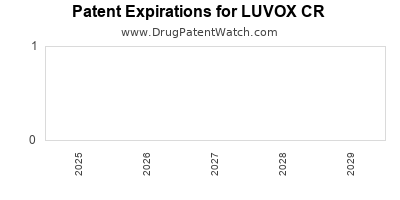LUVOX CR Drug Patent Profile
✉ Email this page to a colleague
When do Luvox Cr patents expire, and when can generic versions of Luvox Cr launch?
Luvox Cr is a drug marketed by Jazz Pharms and is included in one NDA.
The generic ingredient in LUVOX CR is fluvoxamine maleate. There are eleven drug master file entries for this compound. Sixteen suppliers are listed for this compound. Additional details are available on the fluvoxamine maleate profile page.
DrugPatentWatch® Litigation and Generic Entry Outlook for Luvox Cr
A generic version of LUVOX CR was approved as fluvoxamine maleate by AIPING PHARM INC on November 29th, 2000.
AI Deep Research
Questions you can ask:
- What is the 5 year forecast for LUVOX CR?
- What are the global sales for LUVOX CR?
- What is Average Wholesale Price for LUVOX CR?
Summary for LUVOX CR
| US Patents: | 0 |
| Applicants: | 1 |
| NDAs: | 1 |
| Raw Ingredient (Bulk) Api Vendors: | 80 |
| Patent Applications: | 2,630 |
| DailyMed Link: | LUVOX CR at DailyMed |

Paragraph IV (Patent) Challenges for LUVOX CR
| Tradename | Dosage | Ingredient | Strength | NDA | ANDAs Submitted | Submissiondate |
|---|---|---|---|---|---|---|
| LUVOX CR | Extended-release Capsules | fluvoxamine maleate | 100 mg | 022033 | 1 | 2009-04-20 |
| LUVOX CR | Extended-release Capsules | fluvoxamine maleate | 150 mg | 022033 | 1 | 2009-04-13 |
US Patents and Regulatory Information for LUVOX CR
| Applicant | Tradename | Generic Name | Dosage | NDA | Approval Date | TE | Type | RLD | RS | Patent No. | Patent Expiration | Product | Substance | Delist Req. | Exclusivity Expiration |
|---|---|---|---|---|---|---|---|---|---|---|---|---|---|---|---|
| Jazz Pharms | LUVOX CR | fluvoxamine maleate | CAPSULE, EXTENDED RELEASE;ORAL | 022033-001 | Feb 28, 2008 | DISCN | Yes | No | ⤷ Get Started Free | ⤷ Get Started Free | ⤷ Get Started Free | ||||
| Jazz Pharms | LUVOX CR | fluvoxamine maleate | CAPSULE, EXTENDED RELEASE;ORAL | 022033-002 | Feb 28, 2008 | DISCN | Yes | No | ⤷ Get Started Free | ⤷ Get Started Free | ⤷ Get Started Free | ||||
| >Applicant | >Tradename | >Generic Name | >Dosage | >NDA | >Approval Date | >TE | >Type | >RLD | >RS | >Patent No. | >Patent Expiration | >Product | >Substance | >Delist Req. | >Exclusivity Expiration |
Expired US Patents for LUVOX CR
| Applicant | Tradename | Generic Name | Dosage | NDA | Approval Date | Patent No. | Patent Expiration |
|---|---|---|---|---|---|---|---|
| Jazz Pharms | LUVOX CR | fluvoxamine maleate | CAPSULE, EXTENDED RELEASE;ORAL | 022033-001 | Feb 28, 2008 | 7,465,462 | ⤷ Get Started Free |
| Jazz Pharms | LUVOX CR | fluvoxamine maleate | CAPSULE, EXTENDED RELEASE;ORAL | 022033-002 | Feb 28, 2008 | 7,465,462 | ⤷ Get Started Free |
| >Applicant | >Tradename | >Generic Name | >Dosage | >NDA | >Approval Date | >Patent No. | >Patent Expiration |
International Patents for LUVOX CR
See the table below for patents covering LUVOX CR around the world.
| Country | Patent Number | Title | Estimated Expiration |
|---|---|---|---|
| Ireland | 990406 | ⤷ Get Started Free | |
| Hungary | 229569 | Szelektív szerotoninújrafelvétel-gátlók szabályozott kibocsátású többrészecskés kiszerelései (MULTIPARTICULATE CONTROLLED RELEASE SELECTIVE SEROTONIN REUPTAKE INHIBITOR FORMULATIONS) | ⤷ Get Started Free |
| Hungary | 0201884 | ⤷ Get Started Free | |
| Czech Republic | 302388 | Prostredky tvorené více cásticemi s regulovaným uvolnováním selektivního inhibitoru opakované absorpce serotoninu a jeho použití (Multiparticulate controlled release selective serotonin reuptake inhibitor formulation and the use thereof) | ⤷ Get Started Free |
| >Country | >Patent Number | >Title | >Estimated Expiration |
Market Dynamics and Financial Trajectory for LUVOX CR
More… ↓
Make Better Decisions: Try a trial or see plans & pricing
Drugs may be covered by multiple patents or regulatory protections. All trademarks and applicant names are the property of their respective owners or licensors. Although great care is taken in the proper and correct provision of this service, thinkBiotech LLC does not accept any responsibility for possible consequences of errors or omissions in the provided data. The data presented herein is for information purposes only. There is no warranty that the data contained herein is error free. We do not provide individual investment advice. This service is not registered with any financial regulatory agency. The information we publish is educational only and based on our opinions plus our models. By using DrugPatentWatch you acknowledge that we do not provide personalized recommendations or advice. thinkBiotech performs no independent verification of facts as provided by public sources nor are attempts made to provide legal or investing advice. Any reliance on data provided herein is done solely at the discretion of the user. Users of this service are advised to seek professional advice and independent confirmation before considering acting on any of the provided information. thinkBiotech LLC reserves the right to amend, extend or withdraw any part or all of the offered service without notice.
